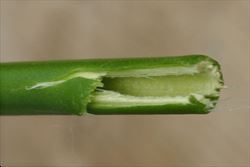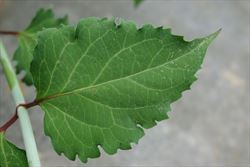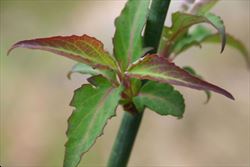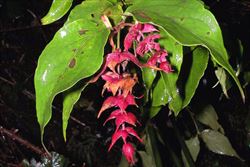Click on images to enlarge

habit (Photo: Trevor James)

stem and paired lower leaves (Photo: Trevor James)

close-up of hollow stem (Photo: Trevor James)

close-up of lower leaf (Photo: Trevor James)

paler leaf undersides (Photo: Trevor James)

leaves and drooping flower clusters (Photo: Trevor James)

young leaves (Photo: Trevor James)

close-up of tubular flowers and purplish floral bracts (Photo: Trevor James)

close-up of flowers (Photo: Greg Jordan)

old flower cluster with persistent purplish bracts (Photo: Greg Jordan)

close-up of immature fruit (Photo: Trevor James)
Scientific Name
Leycesteria formosa Wall.
Family
Caprifoliaceae
Common Names
Elisha's tears, flowering nutmeg, Himalaya honeysuckle, Himalaya nutmeg, Himalayan honeysuckle, pheasant berry
Origin
Native to south-western China, the Indian Sub-continent (i.e. Bhutan, northern India, Nepal and north-eastern Pakistan) and northern Myanmar.
Cultivation
Himalayan honeysuckle (Leycesteria formosa) has been widely cultivated as a garden ornamental in the temperate regions of Australia.
Naturalised Distribution
Naturalised in many parts of south-eastern Australia (i.e. on the central and southern tablelands of New South Wales, in eastern and southern Victoria, in Tasmania and in south-eastern South Australia).
Also naturalised overseas in the UK, southern Europe, New Zealand and south-western USA (i.e. California).
Habitat
A weed gullies, protected hillsides, open woodlands, closed forests, forest margins, riparian vegetation, riverbanks and lakesides in wetter cool temperate regions.
Habit
A multi-stemmed, upright (i.e. erect), shrub usually growing 1-2 m tall, but occasionally reaching up to 3 or even 4 m in height. It loses its leaves during the colder months of the year (i.e. it is deciduous).
Distinguishing Features
-
an upright, multi-stemmed, shrub usually growing 1-2 m tall that loses its leaves during winter.
-
its relatively soft stems are hollow and greenish in colour.
-
its paired leaves (5-24 cm long) have long-pointed tips and entire or toothed margins.
-
its flowers are borne in compact drooping clusters (5-10 cm long) and are surrounded by purplish leafy bracts.
-
these small tubular flowers (about 2 cm long) are white to purplish in colour.
-
its small rounded to egg-shaped berries (about 10 mm long) turn dark red to purplish-black when mature.
Stems and Leaves
The relatively soft upright (i.e. erect) stems are hollow and greenish in colour. Younger stems are finely hairy (i.e. pubescent).
The oppositely arranged leaves are dark green and borne on stalks (i.e. petioles) 5-20 mm long. These leaves (5-24 cm long and 2-12 cm wide) are egg-shaped in outline (i.e. ovate to broadly-ovate) with tapering pointed tips (i.e. long-acuminate apices). They are minutely hairy (i.e. puberulent) and have entire or finely toothed margins. Their lower surfaces are usually somewhat paler than their upper surfaces.
Flowers and Fruit
The flowers are borne in compact drooping clusters 5-10 cm long, and are surrounded by purplish leafy bracts (each about 2 cm long). Each flower has five sepals, that are fused together, and five petals that are fused for most of their length into a tube (i.e. corolla tube). These tubular flowers (about 2 cm long) are white to purplish in colour and nearly equally five-lobed. They also have five stamens and an ovary topped with a style and stigma. Flowering occurs mostly during spring and summer.
The fruit is a rounded (i.e. globose) to egg-shaped (i.e. ovoid) berry that turns from green to dark red or purplish-black in colour as it matures. These fruit (about 10 mm long) contain numerous small brown seeds (up to 1.5 mm long) that are oval (i.e. elliptic) or egg-shaped (i.e. ovoid).
Reproduction and Dispersal
This species reproduces by seed, which are most commonly spread by birds and other animals that eat the fruit. Seeds are also dispersed by water, machinery, vehicles, in contaminated soil, and in dumped garden waste.
Environmental Impact
Himalayan honeysuckle (Leycesteria formosa) is regarded as a significant environmental weed in Victoria, an environmental weed of some concern in New South Wales and Tasmania, and a potential environmental weed or "sleeper weed" in other parts of southern Australia. During a recent survey, it was also listed as a priority environmental weed in two Natural Resource Management regions. This species is mainly introduced by birds into fragile and sensitive moist bushland, where it forms thickets, shades out understorey species, and displaces native vegetation.
Himalayan honeysuckle (Leycesteria formosa) is particularly troublesome in sheltered areas in the higher rainfall areas of Victoria, where it is invasive in damp and wet sclerophyll forests, riparian vegetation and along moist gullies. It is a major environmental weed in a significant proportion of the foothill forest of Mt Buffalo National Park, in north-eastern Victoria, and is also invasive in the Dandenong Ranges and Otway Ranges in the south of the state. Himalayan honeysuckle (Leycesteria formosa) appears on numerous local and regional environmental weed lists in this state (e.g. Knox City, Macedon Ranges Shire, Shire of Yarra Ranges, Mitchell Shire, Mount Alexander Shire and the Goulburn Broken Catchment) and is one of several weed species that are thought to pose a serious threat to the survival of the threatened fernleaf baeckea (Babingtonia crenulata).
Himalayan honeysuckle (Leycesteria formosa) is also widely distributed in Tasmania, where it is almost exclusively found in gullies and damp bushland areas (e.g. wet eucalypt forests) and in other sheltered, moist situations. It is considered to be an important weed in the Queenstown area, in western Tasmania, and is an enviornmnetal weed of local concern in the Central Highlands region. Himalayan honeysuckle (Leycesteria formosa) is also thought to pose a threat to national parks and World Heritage Wilderness Areas close to known infestations in Tasmania. It also appears on environmental weed lists in several other parts of this state (e.g. Devonport City, Burnie City, Kentish Shire, Derwent Valley Council and Glamorgan Spring Bay Council).
Himalayan honeysuckle (Leycesteria formosa) is also becoming an increasing problem in the Blue Mountains region, in central New South Wales. It also appears on environmental weed lists for the NSW North Coast region and the wider Sydney and Blue Mountains region. Overseas, Himalayan honeysuckle (Leycesteria formosa) has been reported to displace native vegetation in a number of temperate regions of the world, particularly in New Zealand where it is relatively common.
Legislation
This species is declared under legislation in the following states and territories:
- Tasmania: D - the importation or sale of this species is prohibited and measures to reduce its population in an area, eradicate it from an area, or restrict it to a particular area may be required.
- Western Australia: Unassessed - this species is declared in other states or territories and is prohibited until assessed via a weed risk assessment (throughout the entire state).
Management
For information on the management of this species see the following resources:
- Muyt (2001), Bush Invaders of South-east Australia, pp. 192-193.

